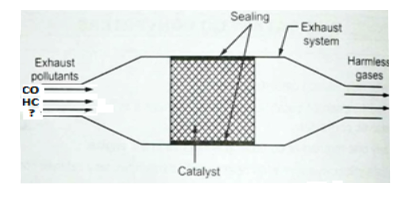Assertion. The catalytic converter in the car's exhaust system converts polluting exhaust gases into non toxic gases
Reason Catalytic converter contains a mixture of transition metals and their oxides embedded in the inner support
If both Assertion and Reason are true and Reason is the correct explanation of Assertion.
Both Assertion and Reason are true but Reason is not the correct explanation of Assertion
If Assertion is true but Reason is false
If both Assertion and Reason are false
The correct Answer is:A
Step-by-Step Solution:
1. Understanding the Assertion:
- The assertion states that the catalytic converter in a car's exhaust system converts polluting exhaust gases into non-toxic gases. This is true as catalytic converters are designed to reduce harmful emissions from vehicles.
2. Identifying the Pollutants:
- The primary pollutants that are typically present in car exhaust include hydrocarbons (HC), carbon monoxide (CO), and nitrogen oxides (NOx). The catalytic converter plays a crucial role in converting these harmful substances into less harmful emissions.
3. Understanding the Role of the Catalytic Converter:
- The catalytic converter contains catalysts, which are substances that speed up chemical reactions without being consumed in the process. In this case, the catalysts are usually made from a mixture of transition metals such as platinum, palladium, and rhodium, along with their oxides.
4. Analyzing the Reason:
- The reason states that the catalytic converter contains a mixture of transition metals and their oxides embedded in the inner support. This is accurate as these metals facilitate the redox reactions that convert the harmful gases into less toxic substances.
5. Redox Reactions:
- The catalytic converter operates through redox reactions. In these reactions, carbon monoxide is oxidized to carbon dioxide, hydrocarbons are oxidized to carbon dioxide and water, and nitrogen oxides are reduced to nitrogen gas and oxygen.
6. Conclusion:
- Both the assertion and the reason are true. The assertion correctly describes the function of the catalytic converter, and the reason accurately explains the composition of the catalytic converter that enables this function.
Final Answer:
- Both the assertion and the reason are true, and the reason correctly explains the assertion.
---
- The assertion states that the catalytic converter in a car's exhaust system converts polluting exhaust gases into non-toxic gases. This is true as catalytic converters are designed to reduce harmful emissions from vehicles.
- The primary pollutants that are typically present in car exhaust include hydrocarbons (HC), carbon monoxide (CO), and nitrogen oxides (NOx). The catalytic converter plays a crucial role in converting these harmful substances into less harmful emissions.
- The catalytic converter contains catalysts, which are substances that speed up chemical reactions without being consumed in the process. In this case, the catalysts are usually made from a mixture of transition metals such as platinum, palladium, and rhodium, along with their oxides.
- The reason states that the catalytic converter contains a mixture of transition metals and their oxides embedded in the inner support. This is accurate as these metals facilitate the redox reactions that convert the harmful gases into less toxic substances.
- The catalytic converter operates through redox reactions. In these reactions, carbon monoxide is oxidized to carbon dioxide, hydrocarbons are oxidized to carbon dioxide and water, and nitrogen oxides are reduced to nitrogen gas and oxygen.
- Both the assertion and the reason are true. The assertion correctly describes the function of the catalytic converter, and the reason accurately explains the composition of the catalytic converter that enables this function.
- Both the assertion and the reason are true, and the reason correctly explains the assertion.
Topper's Solved these Questions
- ENVIRONMENTAL CHEMISTRYBOOK - PRADEEPCHAPTER - ENVIRONMENTAL CHEMISTRYEXERCISE - COMPETITION FOCUS (JEE(Main and Advanced)/Medical Entrance (VI.ASSERTION-REASON) (Type I)
2 Videos
- CLASSIFICATION OF ELEMENTS AND PERIODICITY IN PROPERTIES BOOK - PRADEEPCHAPTER - CLASSIFICATION OF ELEMENTS AND PERIODICITY IN PROPERTIES EXERCISE - Competition Focus (Jee Main and Advanced / Medical Entrance ) ( Assertion - Reason Type Question ) (Type II)
12 Videos
- EQUILIBRIUMBOOK - PRADEEPCHAPTER - EQUILIBRIUMEXERCISE - Competition Focus (VIII. Assertion-Reason Type Questions)
16 Videos
Similar Questions
What is the use of catalytic convertic in automobile exhaust systems ?
View Solution
Observe the diagram of the catalytic converter and answer the questions which follow:
(a) Name any two metals used as catalyst in the catalytic converter.
(b) Name the gases that are released after passing the exhaust hydrocarbons through the catalytic converter.
(c) Name the other poisonous gas which is missing (?) in the exhaust pollutant of an automobile in the above diagram?
View Solution
Knowledge Check
Assertion: The catalytic converted in the car's exhaust system converts polluting exhaust gases into non-toxic gases.
AIf both assertion and Reason are true and the Reason is the correct explanation of the assertion.BIf both assertion and Reason are true but the reason is not the correct explanation of the assertionCIf assertion is true but reason is falseDIf both assertion and reason are false.Assertion. The catalytic converter in the car's exhaust system converts polluting exhaust gases into non toxic gases
Reason Catalytic converter contains a mixture of transition metals and their oxides embedded in the inner supportAIf both assertion and reason are ture, and reason is the trure explanation of the assertion.BIf both assertion and reason are true, but reason is not the true explanation of the assertion.CIf assertion is true, but reason is false.DIf both assertion and reason false.The catalytic converter in the car's exhaust system which converts polluting exhaust gases into non-toxic one contains a _________ catalyst.
AheterogeneousBenzymeChomogeneousDacid-base
As the exhaust passes through the catalytic converter, unburnt hydrocarbons are converted into carbon monoxide and water.
View SolutionAs the exhaust passes through the catalytic converter
View SolutionThe catalytic converters use following metal as a catalyst for reducing the emission of poisonous gases
View SolutionAs the automobile exhaust passed through the catalytic converter
View SolutionAssertion : Catalytic converters must be used in cars.
Reason : Catalytic converter helps to reduce the formation of acid rain.
View Solution
